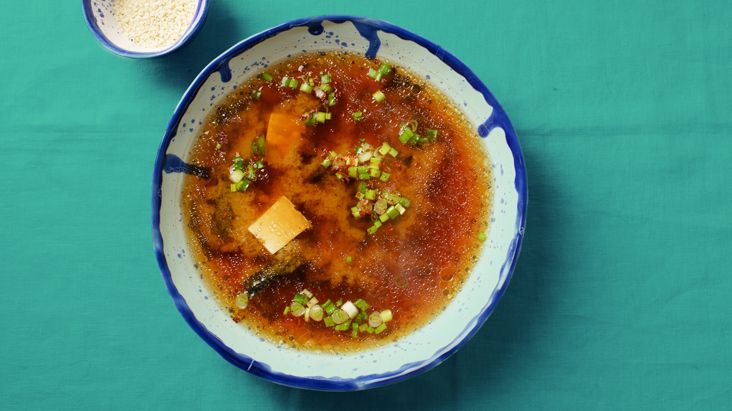Miso soup has MVP potential. From a complimentary starter course at your favorite sushi restaurant to a warming addition to a lunchtime bento box, there’s so much to love about this salty, savory soup.
A fundamental piece of Japanese cuisine, much of the population in Japan eats miso soup at least once per day. It can be consumed at any meal, and (surprisingly) it’s most popular for breakfast.
Miso soup has only grown in popularity around the world. But is it a good option for our vegan friends?
Is miso soup vegan?
Short answer: It can be, but not always.
Miso soup can be made vegan, vegetarian, or pescatarian easily. The most traditional form of miso soup is typically pescatarian, as it includes dashi stock (which is made with dried fish).

A vegan diet excludes all animal-derived products, including dairy, eggs, meat, and fish. Because of this, you do need to inquire about the preparation of miso soup if you’re ordering it out.
Or, even better, you can make your own!
Let’s review some typical miso soup ingredients and which of them fall into the vegan category:
| Ingredient | Vegan | Nonvegan |
| miso | ✓ | |
| dashi stock | ✓ | |
| fish or chicken stock | ✓ | |
| kombu stock | ✓ | |
| vegetable stock | ✓ | |
| tofu | ✓ | |
| abura-age | ✓ | |
| seaweed | ✓ | |
| scallions | ✓ | |
| niboshi | ✓ | |
| bonito flakes | ✓ | |
| soba noodles | ✓ | |
| rice | ✓ | |
| vegetables | ✓ | |
| mushrooms | ✓ | |
| spinach or greens | ✓ | |
| ginger | ✓ | |
| garlic | ✓ | |
| potato | ✓ | |
| daikon | ✓ | |
| egg | ✓ | |
| fish or shellfish | ✓ | |
| pork | ✓ | |
| chicken | ✓ |
Here’s the good news: Miso paste is vegan, which is undoubtedly the most important part of miso soup.
This means it’s easy to make a delicious vegan miso soup. Use a vegetable stock, kombu dashi (made from seaweed), or even water. Include tasty vegan additions such as veggies, tofu, noodles, rice, greens, seaweed, or green onions. Your options are endless!
Miso is a fermented paste mixture made from soybeans, a grain (such as rice or barley), koji (a mold), and salt.
The paste can be fermented for weeks to years. One main rule: The longer miso paste has been fermented, the richer it will taste.
Miso can come in either red or white variety and the taste can vary from sweet to salty-funky goodness.
Dashi is another fundamental ingredient in Japanese cooking and is made from dried bonito flakes, kelp (seaweed), dried sardines, or mushrooms.
Combine these two umami ingredients and you have miso soup. You’ll also likely find little tofu cubes, thinly sliced scallions, and wakame seaweed in most bowls.
A vegan miso soup can taste just as delicious as the traditional version. But if you’re craving something other than miso soup, here are some similar foods and Japanese staples that are vegan and sure to provide lots of umami flavor.
Vegan alternatives
- kombu stock: Japanese soup stock made from dried kelp
- kenchinjiru: Japanese vegetable soup made with tofu, root veggies, kombu stock, and mushrooms
- vegan ramen
- tofu or abura-age (deep-fried tofu pockets)
- soba or udon noodles (try them with peanut sauce)
- tamari or shoyu sauce
- gomashio: a seasoning made from black sesame seeds and salt
- wasabi
- pickled ginger
- umeboshi: salted and pickled plum
- avocado, veggie, or nori sushi rolls
- veggie tempura
- Japanese eggplant curry
- salted edamame with soy dipping sauce
- other miso recipes (did someone say miso tahini avocado toast or sesame miso cucumber salad?)
Seriously, who needs the meat?
We know that there are proven benefits of following a plant-based diet. This includes getting plenty of nutrients, maintaining your weight, and protection against certain cancers — to name a few.
To add to that list, miso soup is rich in several nutrients, including manganese, vitamin K, copper, and zinc.
Since it’s fermented, miso also contains gut-friendly probiotics and has been linked to improving digestion and having an anti-inflammatory effect.
Miso is also an excellent source of antioxidants and has been shown to reduce the risk of certain cancers, especially breast cancer.
While many bowls of traditional miso soup won’t be vegan, making a vegan version of this soup is completely doable and delicious.
Be sure to ask if the soup is made with dashi (includes dried fish) and steer clear from tonjiru (pork), niboshi (dried sardines), or bonito flakes (dried tuna).
Remember you can always make your own! The beauty of miso soup is in its simplicity. You only need very few ingredients and the miso paste itself will do most of the heavy lifting.
Need more inspiration? Check out our vegan grocery shopping list, which contains dozens of foods — including, of course, miso!

